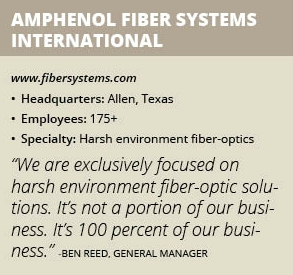Amphenol’s New TFOCA-XBT4 Sets Industry Standard
Its physical contact connector placed the company on the map. But its new product clearly demonstrates that Amphenol Fiber Systems International is on the beam.
The Allen, Texas-based company designs, manufactures and markets fiber-optic interconnect solutions that are designed to withstand harsh environments. They are most often used in military, oil and gas, mining, industrial and broadcast applications.
In October 2016, Amphenol Fiber Systems launched what it considers a top-notch fiber-optic connector in the market: TFOCA-XBT4. It is a new and different take on the company’s flagship product, the TFOCA-II physical contact connector, which is the standard fiber-optic connector for many ground military and industrial applications.
“The TFOCA-XBT4 is a product that takes the best of our product designs and puts it into one connector,” General Manager Ben Reed says. “It’s new and different technology.
We’ve married the rugged hardware of the TFOCA-II with an expanded beam optical insert. This allows us to offer expanded beam technology in a time-proven, rugged connector. Many of our competitors have expanded beam technology, but putting it into a TFOCA-II connector is entirely unique to Amphenol Fiber Systems.”
Adverse Conditions
The TFOCA-XBT4 expanded beam fiber-optic connector is specifically designed to operate in harsh environments. The connector’s lenses enlarge the optical beam at the mating interface, meaning the connector is generally less susceptible to increased insertion loss under certain adverse conditions like dusty environments.
Although physical contact connectors, like the TFOCA-II, are good solutions for certain environments like humid climates, they can be sensitive to dirt, dust and other contaminants. The TFOCA-XBT4 is not as sensitive. “It performs well in dry and dusty environments,” Reed says. “If the lens gets a spec of dust on it, it’s not going to interrupt the signal as it would with a physical contact connector.”
TFOCA-XBT4’s hermaphroditic design enables daisy-chaining of cable assemblies to support varying distances and a non-contacting interface allows thousands of mating cycles. Its cable retention is designed to meet a 400-pound pull strength and Zn-Ni plating provides substantial longevity in corrosive environments. The product also meets a new Environmental Protection Agency mandate for eliminating heavy metal plating. The TFOCA-XBT4 and TFOCA-II are both registered trademarks of Amphenol Fiber Systems.
Hybrid Demand
Amphenol Fiber Systems offers one of the broadest portfolios of both expanded beam and physical contact connectors. It also makes hybrids, which have been growing in popularity in the  past few years.
past few years.
“A hybrid connector design has both fiber-optic termini and electrical contacts,” Reed says. “It’s very efficient. It saves space, allows for more high-speed data and helps with organization. For example, instead of having four or five connectors in tight spaces like equipment panels, you have one.”
Hybrid connector designs are favored solutions for oil and gas, military and medical industries. “We’ve been offering hybrid versions for years,” Reed says. “But what’s new is that there’s an increase in customer demand. In general, people want solutions that are lighter, smaller and faster.”
In addition to hybrids, Amphenol Fiber Systems is also seeing demand for certain physical contact connectors.
The company has been selling variations of its NGCON fiber optic connector since 2007, but given its success it launched a new configuration of the product in 2017.
It features a rear release termini, genderless termini, high-density arrangements and wall-mount and jam-nut receptacle configurations. Its applications include avionics, military and naval shipboard and dockside communications. “The product is meant to be the next generation of physical contact fiber connectors,” Reed says. “It marries the best features of legacy products.”
Expanded Resources
Amphenol, a global manufacturer of electronic and fiber-optic connectors, purchased Fiber Systems in 2005, renaming it Amphenol Fiber Systems International.
Founded in 1993, Fiber Systems originally focused on supplying components for a handful of military products and soon became a certified Department of Defense supplier.
In the late 1990s, the company developed TFOCA-II, which eventually became the standard tactical fiber-optic connector for the U.S. Army and placed Fiber Systems on the map.
By 2000, Fiber Systems had begun developing internal machining capabilities to complement its assembly lines. The investment improved lead times and quality by giving the company the ability to fabricate most parts in house. That allowed Fiber Systems to expand its product lines to the broadcast and geophysical market, including the mining and oil and gas industries.
When Amphenol bought Fiber Systems, the acquisition opened Fiber Systems to all of the larger company’s resources and shared knowledge. It had access to Amphenol’s worldwide facilities and sales networks. Fiber Systems could tap into Amphenol’s entire manufacturing and sales network and find other Amphenol entities it could share parts and capabilities with.
Amphenol Fiber Systems is known as a full-service fiber-optics company that specializes in products for harsh environments. “We are exclusively focused on harsh environment fiber-optic solutions,” Reed says. “It’s not a portion of our business. It’s 100 percent of our business. Our expertise really differentiates us. We have one of the largest harsh environment fiber-optic portfolios out there.”